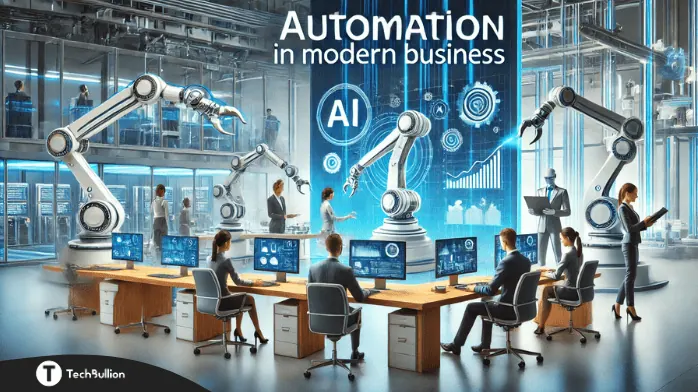
In today’s fast-paced world, automation in modern business has become a transformative force, reshaping industries and redefining how companies operate. From enhancing productivity to streamlining workflows, automation plays a pivotal role in driving growth and maintaining competitiveness. This article delves into the critical aspects of automation in modern business, its applications, benefits, challenges, and how businesses can leverage it to stay ahead in a dynamic market.
Understanding Automation in Modern Business
Automation in modern business refers to the use of technology to perform tasks with minimal human intervention. By leveraging tools such as artificial intelligence (AI), robotics, and software solutions, businesses can automate repetitive, time-consuming tasks, allowing employees to focus on strategic and creative endeavors.
Key Components of Automation
- Robotic Process Automation (RPA): Automates routine administrative tasks like data entry, scheduling, and invoicing.
- Artificial Intelligence and Machine Learning: Drives decision-making and predictive analytics by processing vast amounts of data.
- IoT (Internet of Things): Facilitates real-time monitoring and integration across devices and systems.
- Workflow Automation Software: Streamlines operations like customer service, payroll, and marketing campaigns.
Benefits of Automation in Modern Business
The adoption of automation offers multifaceted advantages, empowering businesses to operate efficiently and effectively.
1. Increased Efficiency and Productivity
Automation reduces manual interventions, allowing processes to run faster and more accurately. For example, e-commerce businesses use automated inventory management systems to track stock levels in real time, ensuring timely restocking and seamless operations.
2. Cost Reduction
Automating repetitive tasks significantly reduces operational costs. Manufacturing industries benefit from robotics, which minimizes labor costs and material wastage. Tools like automated payroll systems streamline financial processes, cutting administrative expenses.
3. Enhanced Accuracy
Automation ensures consistency and minimizes human error. Tasks like invoice generation and order processing achieve near-perfect accuracy, boosting customer satisfaction and trust.
4. Scalability
Businesses can scale operations effortlessly with automation. Whether it’s managing higher production volumes or handling an influx of customer queries, automated systems adapt seamlessly to growing demands.
5. Improved Customer Experience
Automated tools like AI chatbots and CRM systems enable businesses to offer personalized, 24/7 customer support. These technologies respond instantly to queries, ensuring a positive customer experience.
Applications of Automation Across Industries
Automation in modern business transcends industry boundaries, offering innovative solutions tailored to specific needs.
1. Manufacturing and Production
- Use of Robotics: Robots perform assembly, packaging, and quality checks with precision.
- Predictive Maintenance: IoT devices monitor machinery for potential issues, reducing downtime.
- Real-Time Scheduling: Automated systems optimize production timelines based on demand forecasts.
2. Supply Chain and Logistics
- Inventory Management: Automation ensures accurate stock levels, preventing overstocking or stockouts.
- Route Optimization: AI-powered tools identify the most efficient delivery routes, reducing costs.
- Warehouse Automation: Robotic systems handle sorting, packing, and shipment preparation.
3. Customer Service
- Chatbots and Virtual Assistants: AI tools address customer queries instantly and provide personalized recommendations.
- Automated Ticketing: CRM systems prioritize and assign customer issues to the appropriate teams.
- Feedback Analysis: AI processes customer feedback to identify trends and areas for improvement.
4. Marketing and Sales
- Email Campaign Automation: Tools schedule and execute email campaigns based on customer behavior.
- Lead Scoring: AI evaluates potential customers, helping sales teams focus on high-value prospects.
- Behavioral Analytics: Automation tracks user activity, enabling businesses to deliver targeted ads and offers.
5. Finance and Administration
- Payroll Management: Systems like pay stub generators automate salary calculations and documentation.
- Expense Tracking: Automated tools categorize and analyze expenses, streamlining financial reporting.
- Compliance Management: Automation ensures businesses adhere to regulatory standards by monitoring and updating records.
Challenges in Implementing Automation
Despite its numerous benefits, automation comes with its own set of challenges that businesses must address for successful implementation.
1. High Initial Costs
The upfront investment in automation tools, infrastructure, and training can be prohibitive for small and mid-sized enterprises. A clear ROI strategy is essential to justify these expenses.
2. Workforce Displacement
Automation often replaces manual tasks, leading to job displacement. Businesses must invest in upskilling and reskilling programs to help employees transition to more strategic roles.
3. Cybersecurity Risks
Automated systems rely heavily on interconnected networks, making them vulnerable to cyber threats. Robust cybersecurity measures, such as encryption and regular audits, are crucial.
4. Resistance to Change
Employees and stakeholders may resist adopting automation due to fear of job loss or disruption to familiar workflows. Clear communication and change management strategies are necessary to overcome this barrier.
How to Successfully Implement Automation
For businesses to thrive in an automated landscape, a strategic approach to implementation is crucial.
1. Assess Business Needs
Identify tasks and processes that can benefit from automation. Prioritize areas with repetitive workflows, high error rates, or scalability challenges.
2. Choose the Right Tools
Select automation solutions that align with your business objectives. Evaluate vendors based on their technology’s scalability, ease of integration, and support services.
3. Train Employees
Equip your workforce with the skills required to operate and manage automated systems. Encourage collaboration between technical and non-technical teams for seamless adoption.
4. Monitor and Optimize
Regularly assess the performance of automated systems to ensure they meet desired outcomes. Use analytics to identify bottlenecks and opportunities for further optimization.
The Future of Automation in Modern Business
Automation’s influence on modern business is set to grow, with advancements in AI, machine learning, and IoT driving the next wave of innovation.
1. Hyper-Automation
Hyper-automation involves integrating multiple automation tools to create end-to-end automated processes. This trend will enable businesses to achieve unprecedented efficiency and accuracy.
2. Autonomous Systems
From self-driving vehicles in logistics to AI-driven customer service bots, autonomous systems will redefine industries, enhancing operational independence and reducing reliance on human intervention.
3. Sustainability
Automation can support sustainable practices by optimizing resource use and reducing waste. For instance, AI tools can analyze energy consumption patterns, helping businesses minimize their environmental footprint.
4. Human-Automation Collaboration
Future advancements will focus on augmenting human capabilities rather than replacing them. Collaborative robots (cobots) and AI assistants will work alongside employees, enhancing productivity and innovation.
Conclusion
Automation in modern business is not just a trend but a necessity for companies aiming to remain competitive in an ever-evolving market. By streamlining operations, reducing costs, and enhancing customer experiences, automation empowers businesses to focus on innovation and growth. While challenges like initial costs and workforce displacement require strategic planning, the long-term benefits far outweigh the drawbacks.
As technology continues to evolve, automation will drive new opportunities for businesses, enabling them to thrive in a fast-paced, technology-driven world. Embracing automation today ensures success in the future, making it an indispensable component of modern business strategy.




